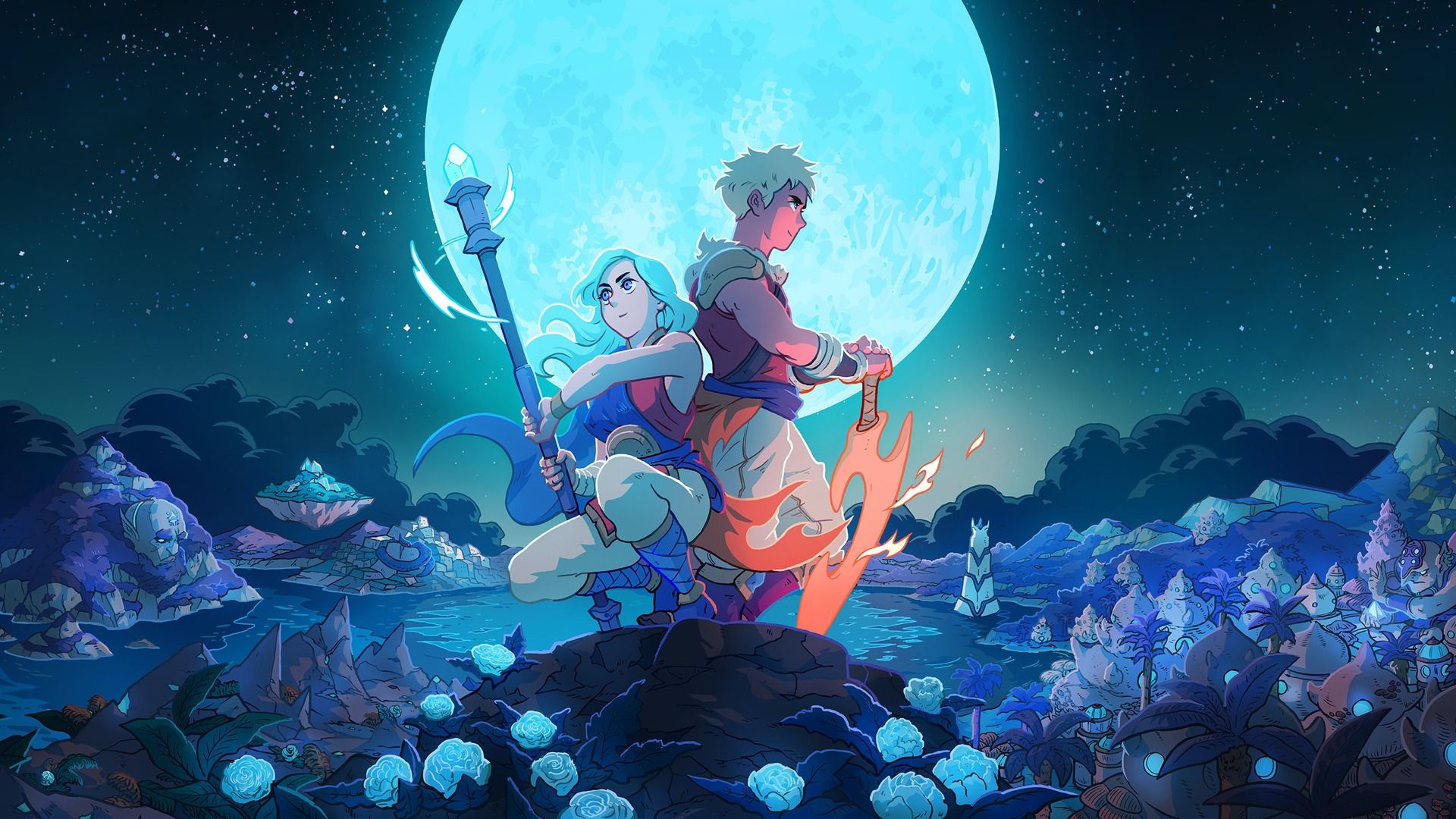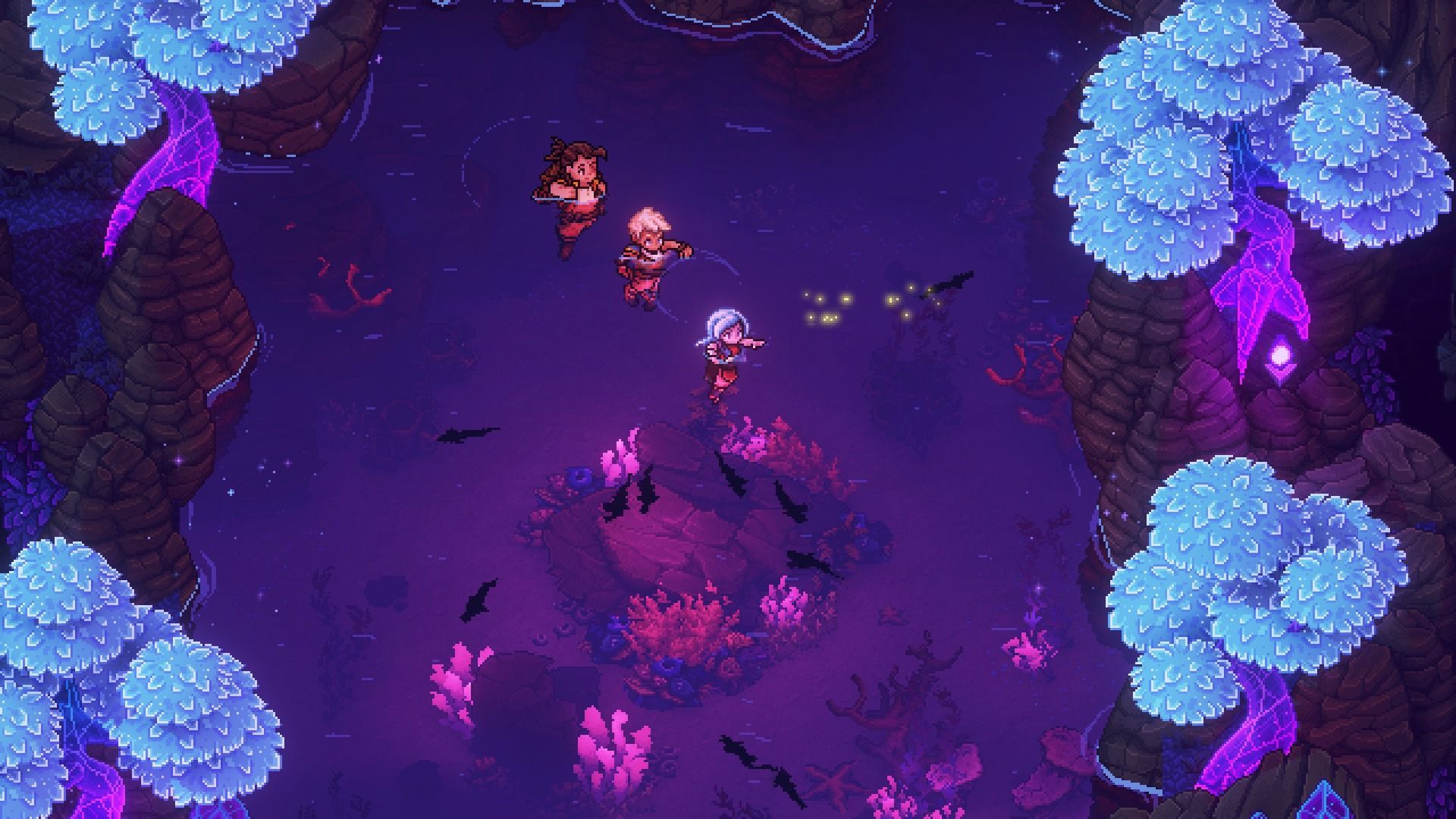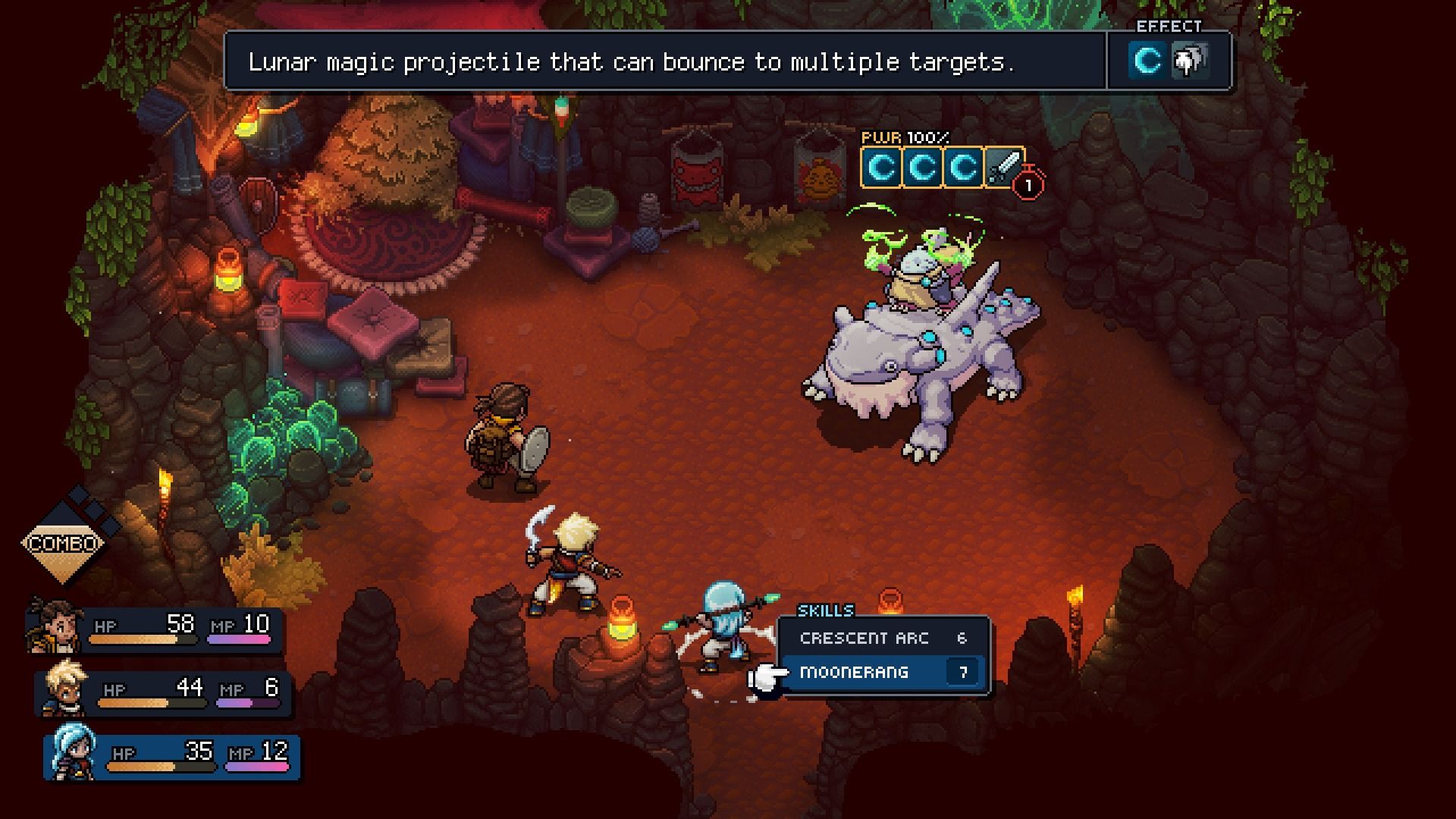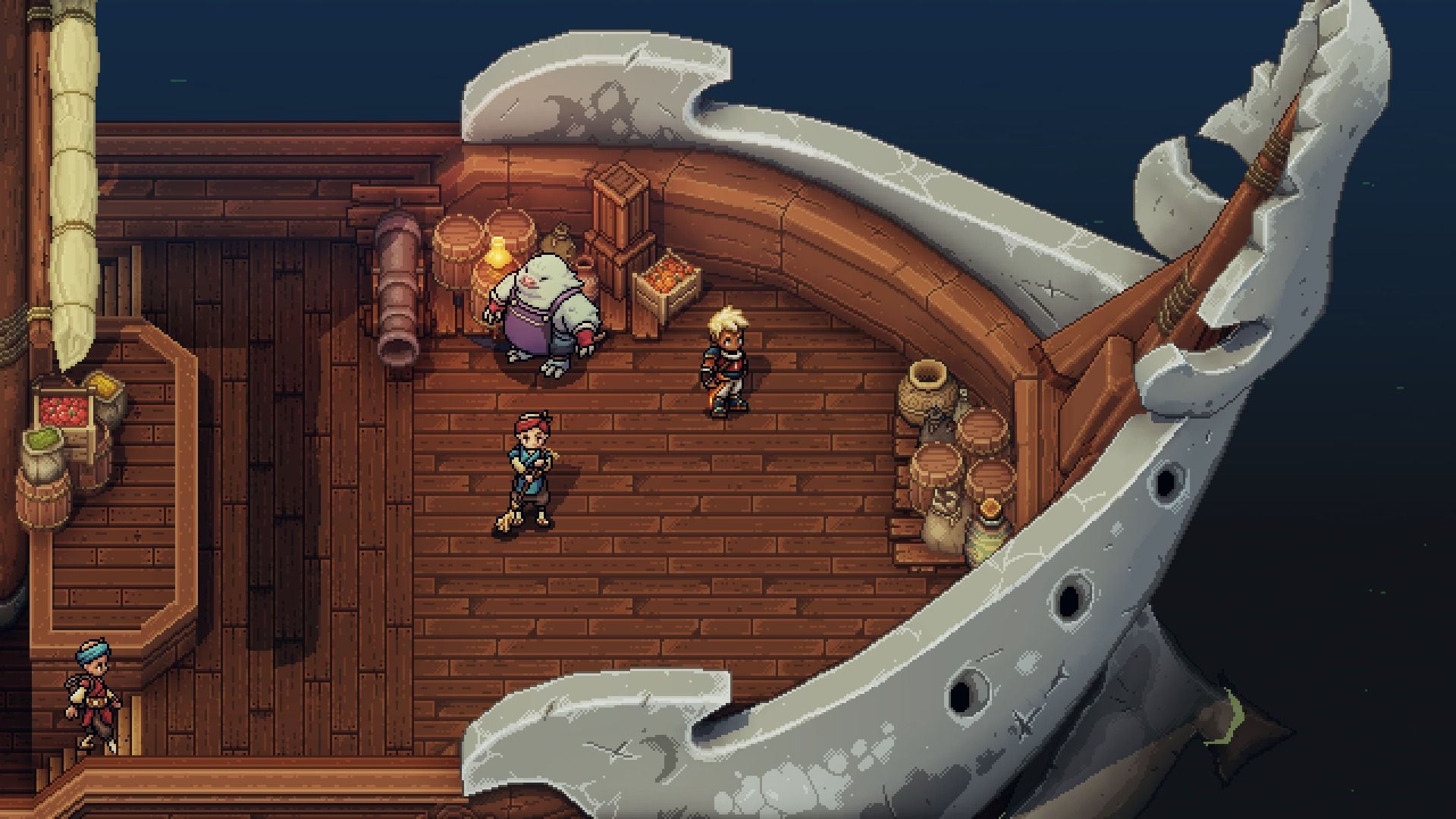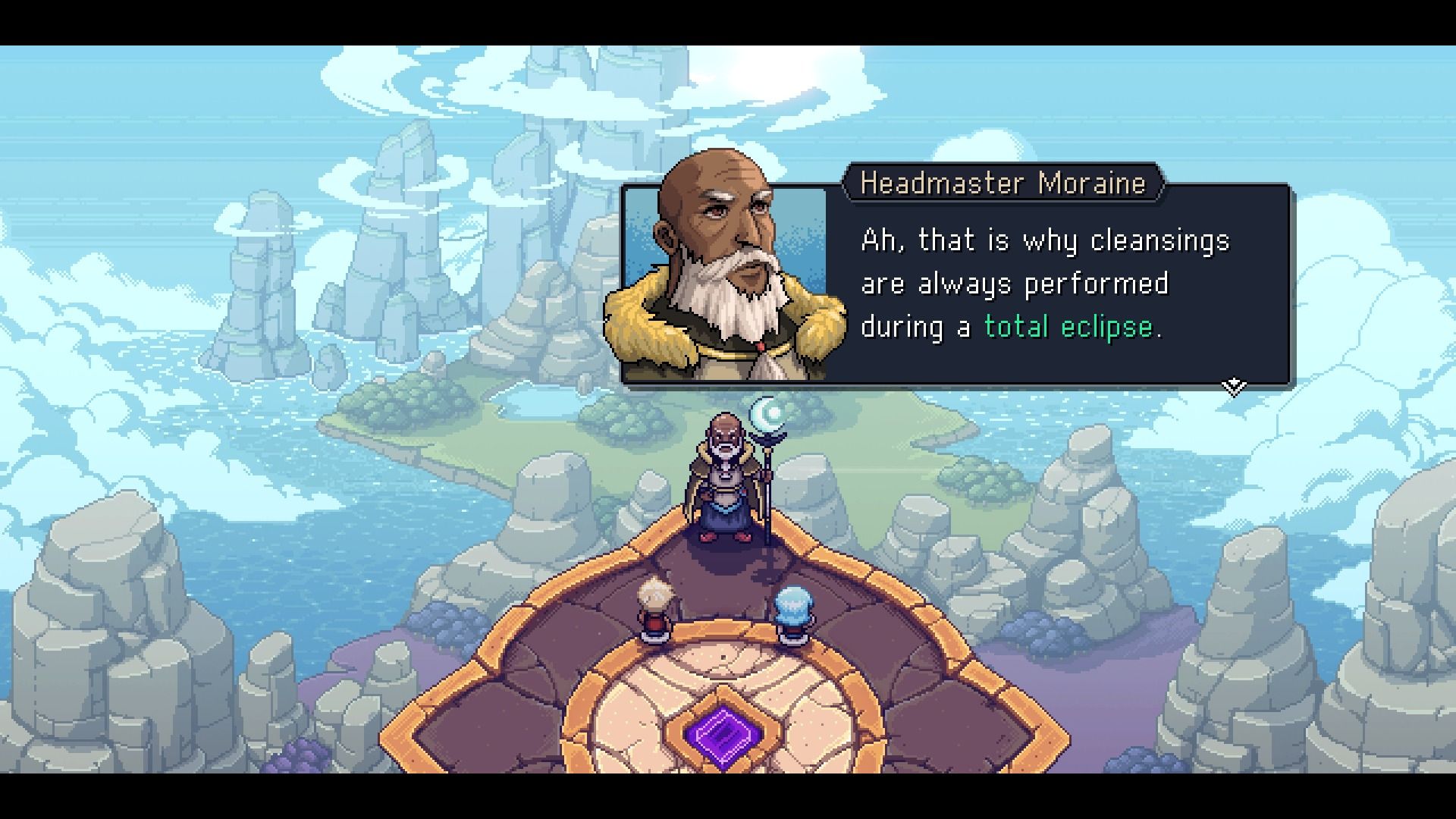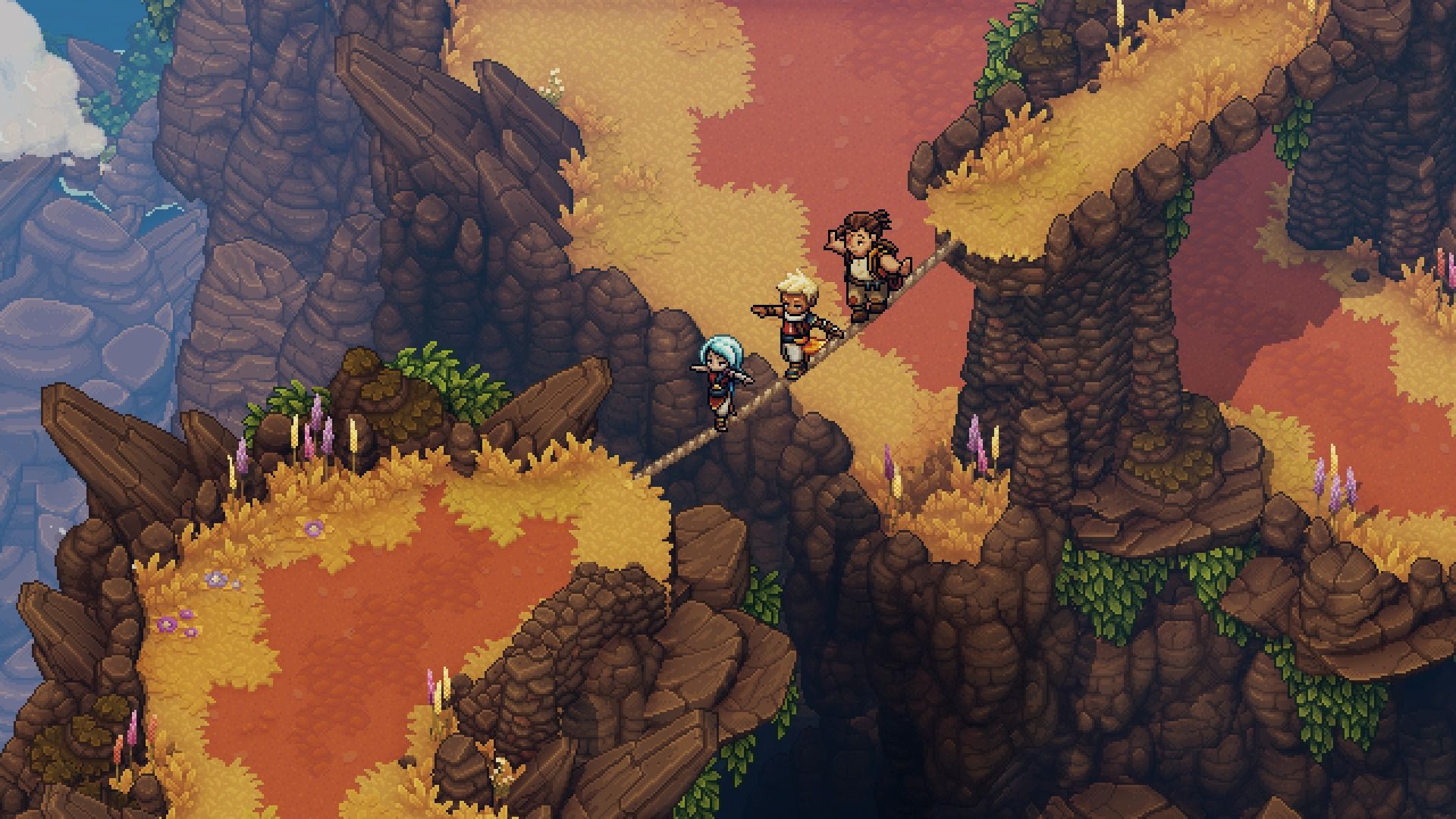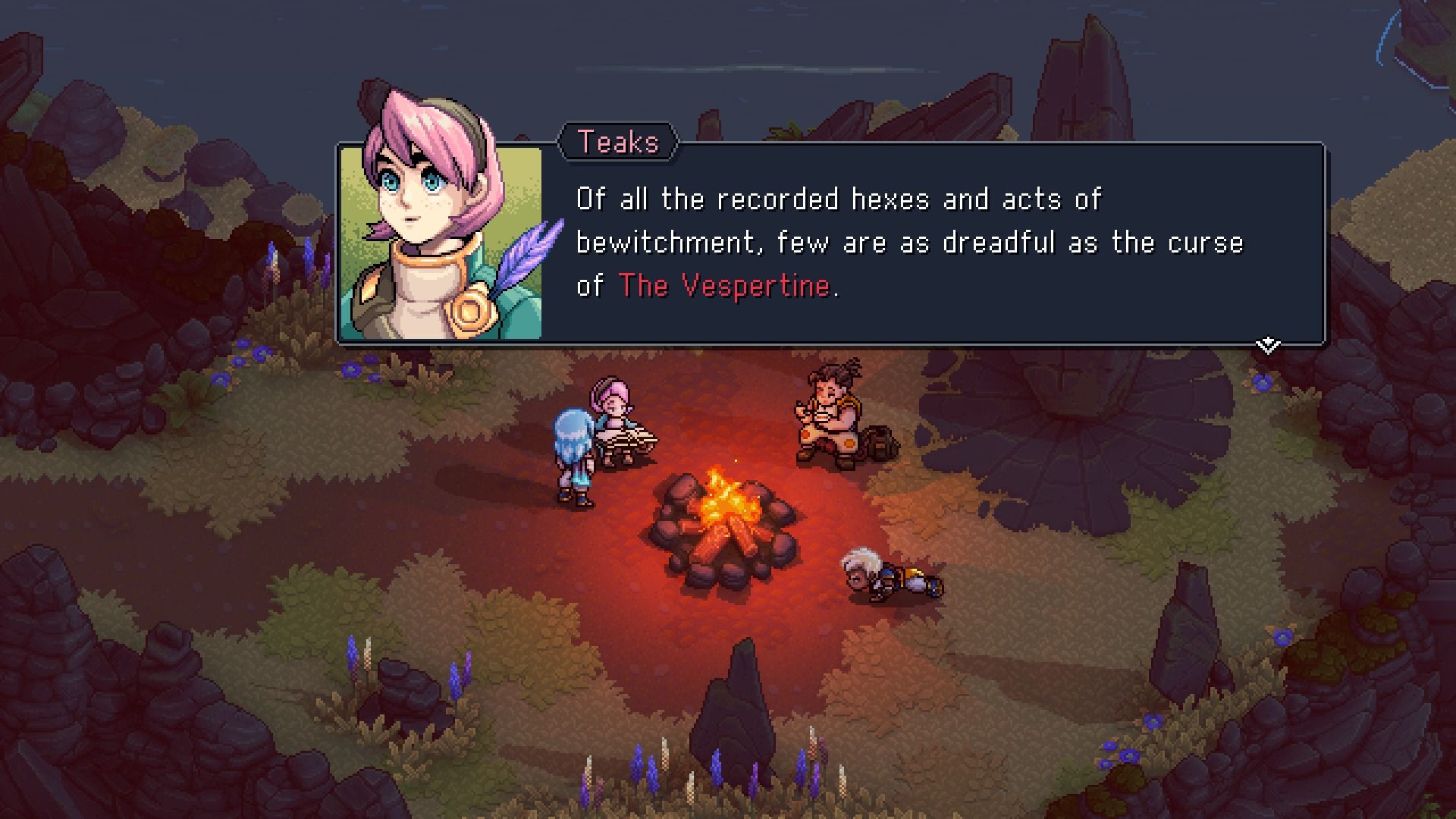Sea of Stars, set for release on August 29, aims to recapture the best elements of classic Japanese RPGs while finding new ways to innovate in the genre. In the hands of the developer behind The Messenger, Sabotage Studio, this goal might not be impossible. Pulling it off, however, requires traversing a tightrope above a higher pitfall than any found within the game.
Set in the same universe as The Messenger, Sea of Stars tells the story of Valere and Zale, two Solstice Warriors imbued with the power of the moon and the sun. As they set out to face the threat of an evil alchemist known as the Fleshmancer, they’ll meet a handful of other companions and face a variety of unique enemies and environmental challenges rendered in a gorgeous pixel world.
Related: “More Than Just an Excellent Turn-Based RPG”: Sea of Stars Review
Screen Rant sat down with Thierry Boulanger, the creative director of Sabotage Studio, to discuss Sea of Stars at length. From creating an RPG without grinding to making a fantasy world feel real, Thierry had plenty to say about the concepts behind the new game, although any surprises that await within the story remain in the shadows.
Screen Rant: Sea of Stars was first revealed several years ago with a very successful Kickstarter campaign. What do you think drew so many people to the project?
Thierry Boulanger: It’s hard to tell for sure why, because we don’t do market research, it’s just like, we’ve always as a team wanted to make this game together. So the Kickstarter was the test — is there a response, if we commit, if we go all in, are there people to buy it in the end?
I think part of the reason why it resonated is, of course, at its core, it calls back to games that a lot of people fondly remember. And it seems to follow the codes of just the general vibe that it seems like there’s been a shortage of, in terms of the genre or at least it being fully fleshed out in a production. I think it called to very clear themes, and also there was a proposition to modernize a little bit. To take the conversation a little bit further in terms of the traversal, how you can touch the environment and the active gameplay within all of that. I think it all kind of came together in a proposition that people were excited about.
The market shows that with RPGs, and particularly Japanese RPGs or games inspired by those, there’s been a desire for people to play stuff in the 90s old school vein, from Western indie games doing something similar to, say, the HD-2D games happening over at Square Enix. What do you think Sea of Stars brought to this space specifically that you couldn’t find in other alternatives?
Thierry Boulanger: I think there’s a simplicity to retro games where for me, one thing that was really important is you’re not stuck in town for the first 30 minutes of the game trying to figure out how to get out for the action to start already. That was one of the first of the five core tenets of the game, one of the five was you hit something with your weapon within four minutes of starting the game. Or even two minutes in this case. I think there’s really something about the simplicity. If you think about the pixel art, it can be the music as well. It’s these limitations, this idea of keeping it simple. All the crafts, all the pillars have to kind of get to the point and distill something that you can just have right away.
So it doesn’t drag. It’s not a game where you feel like, ah, do I want to pick up the controller because it’s going to be super involved for three hours? Otherwise it’s not worth picking up. It feels more distilled, crunchier in a way.
I think it calls to a simpler — I don’t want to say simpler times, because what’s being made today is also great. But I think there is still a demand, and the reason why the old classics are still being replayed is they had that simplicity, that thing that they did that modern games can’t really do. So it was the idea was to propose a new entry that aims at holding up amidst all these classics.
You mentioned five core tenets for the game. Can you talk more about those?
Thierry Boulanger: Sure. One of the five was you hit something right away, because for me it was The 7th Saga, one of the classics where you play the intro super long, and the second I enter combat — it’s like a first person thing — I need to see my character. It’s like I just invested all this time, and I don’t really care for that combat system. So it was just to make that proof right away. That was one, and the others are more involved. One was it being a world you can touch, so that’s a more generalized idea, right? That everything feels kinetic and also everything feels diegetic. It’s in very simple things like, to save, it’s a book that looks like it’s a book that belongs in that world, and you’ve got the Archivist. So it’s understood that you’re sending a page out to this character that overarches everything. Instead of feeling like you are on your catwalk or in your little trail and there’s art around you, if it looks like you can touch something, you can actually go there. There are no invisible walls that don’t make sense.
So that kicked into a second pillar, which was unshackled traversal. The idea that you can just hoist up, jump down off of everything. The fact that there’s a verticality to the gameplay, I think, is pretty rare with that type of rendering and camera angle. How you go in and out of water seamlessly. It’s not a press A, fade out, fade in, you’re swimming, or there’s an entry point to changing the game state. Everything is: as you’re swimming, if you can grab, you can just hoist up, you can just jump back down from any height. This whole idea of going as far away as possible from tile-based movement, if you will.
So then the idea that everything would take place — like, no random encounters, right? — everything takes place in the world that you are traversing. Once you play it, if hopefully we got it right, it just feels natural. It’s actually a very big challenge because navigation or traversal, like moving around exploring a dungeon, is just a level design thing. How do we give you bits that are just fun to interact with and all isolated. Oh, here’s a tightrope, here’s a climbable area. But to have battle in there in a way that will still feel organic, to not fall into the trap of “Oh, here’s a very tight corridor, so for sure I’m not going to fight anything here. And then there’s a big open empty square because I need room for combat.” I think integrating these battle arenas inside levels that were meaningfully traversable was one of the things that we put the most effort into.
And then for it to all read well with different levels of height, with the light and everything, and that you still know where to go. If you had something like random encounters, where the battle takes place in an area that you load in, then you can just do whatever you want with the level because combat can just happen on a tight rope or whatever. We really made a point for everything to stay connected because I feel it builds more of a sense of a world. Again, it kicks back into the world you can touch, that the place is actually real. Same with the world map — it lets you map in your mind, “oh, where am I compared to this other place?” All of this contributes or comes together for a stronger sense of the world actually existing.
There are a lot of little details too, say when you’re walking by a path and a bird might fly off into the air. Aspects of both the art and what’s placed into the environment that make it feel a little more alive than a lot of pixel games might in that regard.
Thierry Boulanger: Right. And I think that’s part of taking the conversation further. I don’t know if you’re familiar with Breath of Fire IV?
I haven’t played it. I’m baseline familiar with it.
Thierry Boulanger: Okay. That was one of the examples that we were talking about where it felt like, maybe that’s a production where combat and traversal didn’t make sure things mesh so much. You can change your camera 90 degrees, four times, so you get that 360 in locked-in angles. And sometimes you’re just walking one way, and then you get a random encounter, which gives you a fixed angle perspective. And then when you return, you have a full screen of trail in the forest with no landmarks, and you’re like, “Was I going this way or that way? Did I rotate the camera before that combat? I was involved for a few minutes.” Sometimes you went back to the start of a dungeon when you thought you were progressing, but you had shifted your perspective and didn’t even realize it.
A lot of what you speak to with the birds and things like that, sometimes if you watch them fly off, it’s because they show you something that you can loot or whatever. We’re trying to let the player take in the world, and never do anything where you can lose the sense of perspective. Nothing happened in the silo during production. It was always all the core gameplay loops making sure to resonate with one another.
With the Chrono Trigger-influenced encounter system, where you don’t have the very classical random encounters, everything feels like an enemy is placed in a distinct setting in the world. How did you go about figuring out the encounter rate you wanted in that regard? How frequently you wanted players to be fighting enemies, and how many times they might fight the same kind or meet a fresh one?
Thierry Boulanger: One thing that that does really well is we can kind of decide how many encounters you’re going to have. And some of them are kind of forced. They’re more scripted. Like when you arrive someone whistles and you have to do that fight. These fights are like permadeath, right? But the ones that respond, they just kind of patrol, and you can dodge them if you want. It really came down to pacing. I don’t know that there’s a specific guideline that we had, but we wanted to keep it feeling light.
That’s one big takeaway from Chrono Trigger. With the dungeons you always kind of have that expectation, like, is that going to be a task? Is that going to drag on? But it’s always done before you are, For me this was a really big lesson. I don’t wish there was more because it’s so light and so perfectly distilled that I get way more play time out of that game. I’ll care to replay it seven times because there’s no tedium. I can’t speak to — you know, that’s up to people who play it. But we certainly set out with that vision in mind, that what we do is we dare to use something bespoke only once if it’s a really cool VFX. It’s not like, “Oh, we want to get our money’s worth in terms of production, and we’re going to use that explosion four times or whatever.” No, we use it one time, and it’s been seen hundreds of thousands of times because of everyone who will see it only once.
I think this idea that every dungeon adds new enemies and removes the old ones also has this thing where it’s not just, “Oh, it’s the same thing, but now it’s red instead of blue or whatever.” There’s very, very little reuse. Every new area contributes a new biome, and that also means new enemies. That’s all in the spirit of keeping it fresh. And you just keep progressing, you never really hit a wall in terms of progression.
The enemies have very distinct attacks. With the timing system that’s included in combat, there are moments where a player might be figuring out, “They’re moving up against me twice and then they’re slashing with this. So I have to figure out the timing here, and then I can master that.” Which would be a lot of work for enemies throughout a game. Were there any particular enemies that you or the development team are very fond of or were really excited about what you did with them?
Thierry Boulanger: Yeah, there’s a zombie-type enemy that’s a bit further than where you’re at. We gave this one super erratic behavior in combat. It’s kind of like an ADHD monster. It’s not paying attention to combat, and it will attack its companions, or it does a disco pose and can smoke bomb and just escape battle randomly. There are a few like these, but it would really be hard to pick a favorite, I wouldn’t say that any were more challenging than others.
With the bigger pieces, we really went full-on pixel art. No shortcuts. Some of them took a lot more time. I’m not clear where you’re at exactly in the game.
I’ve just gotten to the Stonemasons Outpost and entered the dungeon there.
Thierry Boulanger: Okay. So the giant that throws you and the other one that catches you? These animations, they took weeks, they took over a month, each of them. It’s full screen, the pixel art is point by point. It just took so much effort, and you want to think, “Oh, do we pre-render that using vector graphics and then just kind of paint over?” No, let’s actually do it. We really fully committed, because we wanted the whole thing to really be cohesive. So yeah, some of them were more work in terms of the sheer amount of dots to punch in. But we were blessed with a very good animation team and a very good character artist team.
What’s fun, though, from the gameplay perspective is that every enemy and your own attacks and your own special skills have timing to them. They will grow on you because you keep using them throughout the game, so they’re familiar. But then any new enemy kind of resets the conversation. Because by the time — you mentioned you end up mastering how to block a specific attack — but then you’re done with the dungeon. You’re also done with that enemy, before it becomes stale.
Again, it’s all if we did it right, but the intention was you’ve mastered this, okay, so now you go into a new place, you know your attacks so you can use them, but every move you see from the enemy is a new pattern to learn. So if you fail on a boss, it’s not go back and grind more XP or whatever. It’s oh, you can learn, you saw a few of the patterns, you can execute better the next time around, and that’s also another way that you can grow within the game.
Did you ever consider, with combat, going down the path of either real-time action, like Illusion of Gaia, or fully turn-based? Or was the idea of a turn-based system with timing always the prerogative?
Thierry Boulanger: It was for sure not going to be action, because something like Illusion of Gaia — and it’s one of my favorite games of all time — but no, that one was for sure going to be turn-based. I will say party-based, even more so than turn-based, which we can talk about Secret of Mana and things like that. But I feel like, to have like party-based combat with big enemies and all, for it to really feel right, and you feel like it connects, it felt right to go the turn-based route. It really supports, I think, the story and everything, because you have up to six playable characters in total. Swapping them in and out and things like that kind of kicks into that more tactical dynamic.
And then having pure turn-based instead of time bars, right? The reason there is for that Super Mario RPG timing hits thing. If a bar is ready, then a menu pops up, if you press the block or you’re also selecting something, it’s just kind of like, we want you to focus on the actions one by one.
And also, I personally — and that’s just personal preference — but I think that without having the time bars, pure turn-based allows for that more tactical approach to gameplay. We don’t have to balance for a variance where, well, do you get three actions in before the boss does something, and that other player only gets one in because they’re like slower at deciding what to do next?
So the idea of just relax, it’s your turn, just browse whatever you want. Go through your characters, look at the lock patterns that you see. And there’s not a timer that’s like hey hey, if you don’t decide fast, something is going to hit you. So it means that the balancing can be way tighter because we control how many player actions you get before at the ultimate attack of the boss happens or something. It’s more contained into something we can balance meaningfully.
One other tweak to fully classic turn-based combat is that here, if all three of your characters have an available action at the moment, you can choose which one you’re going with. How did you settle on that originally?
Thierry Boulanger: Oh, that was always in place. One of the things for me is I really love to remove friction. Wherever there’s friction, it’s like, no, let’s remove it and balance to account for the fact that there’s no friction there. And what that does is that, just to take an example from the characters you have at the moment, if the lock pattern that you get is you need to do one Sword and one Moon hit on the target, and you have two turns, and it’s like, well, no, it’s Garl’s turn, and you can’t do anything about it. Well, he’s not going to do Sun. He’s not going to do Moon. And then you only have one action left. And you can only take out one of the two. So that spell has to go. So now instead it’s like you have two turns, you have two characters that can do this. If you choose your order of actions, you can choose, “I’m going to break this spell, I’m going to let that one fly. I’m going to earn a combo point from that one, and then in a single move I can remove the other one.” And it creates the whole tactical gameplay that makes sense.
Another friction point too that I want to speak to is that, because there’s three more playable characters that you don’t have yet, and they also each contribute attack patterns, special skills, and damage types that they can do. You only have three active characters, but it adds the swap function, so you can swap in someone from the back row into the front row. And that also costs nothing. You can swap someone for a character that’s not in the combat, and then they get to act right away.
You can also just place them there and go to someone else just because you want them there to take the hit or something. So all of that is frictionless, and there’s no cost. You just use your party and play with the damage patterns. And you’re never missing out in that fashion. It’s all about your tactical approach to it.
You have playable characters in here, and you also have non-playable characters who can tag along. Was there a defining factor between going, okay, someone like Teaks, this is a traveling historian, we’ll make her a non-playable character? Figuring out who would go where and how to build a robust party and also maybe have characters on the side who weren’t there for that same reason.
Thierry Boulanger: Right, right. For sure. The thing with Teaks was she’s not, in her backstory and in who and how she is and what she learned and what she knows, she’s just not someone who fights. But the idea is that we really have a crew of support characters that are on the journey with you, even if they don’t do the dungeons and they don’t do the fights.
I don’t want to necessarily tell you what happens next and how that shakes out. But you feel like you kind of have your little crew and your little place where they all hang out, right? And you can talk to them, and they’re along for the journey, even if they’re not in your battle party. Even though she doesn’t fight, she’s there throughout, and then you could have a moment in 12 hours where she’s like, “Oh, I know about this, let me help,” or “Let me talk to someone” or “I found something.” She keeps contributing to your story, but also she plays the role of a support character where, as you find other artifacts, she can touch them with her book. It writes new stories in it, and then if you care to go for the campfire story time, you can do that. I hate to just lore dump on players who don’t necessarily care for that. But if you’re curious about more of the backstory of that world, then you can ask to be told the stories that you’ve unlocked.
Speaking of that world, this is a universe that you’ve been dreaming up since you were a kid. What is it like to polish that on the level of a product like this and The Messenger and share that with the world?
Thierry Boulanger: It’s amazing. That’s the thing I can’t say enough, but the ridiculous amount of talent that gathered around. You think it up, you’re eight. You’re like, yeah, it’s probably stupid. But I kind of held onto it and refined it in my mind, and then it’s like, hey, let’s create something pretty that people can get lost into. And then people just gather around it and they start “yes, and”-ing, and they want to build it. They have ideas that they see in it, and they add little tidbits of their own. Like, “Oh, what I really like is when things do this or when a story goes like this.” I’m like, “Oh yeah, I have a character for that. Maybe we can…”
So building it for sure has been a journey. There is something vulnerable about this, because it’s like, hey, you know, if you don’t like it, if you’re mocking it, it’s kind of a lot of rejection to be exposed to. But I feel like I’m surrounded by enough talent, and they all felt it was a worthwhile creative pursuit. Then I’m like, if it’s good enough for them, it’s probably good enough.
But yeah, it’s a real blessing. I couldn’t be happier to get to do all of this.
This is an expanded team size from The Messenger as well. How was it adjusting to not only the expanded potential of having more people on the team, but also having to bring more people into a core creative loop like that?
Thierry Boulanger: The main thing is, because most of the people who are here, even though we grew by about 4x the studio, were mostly people who we had worked together in the past. And the idea to make Sea of Stars was always there. So right now I’d say we’re at our finalized team size in terms of the scope of games that we want to make.
And it’s more that with The Messenger it was like, we’re bootstrapping this, right? We’re making something smaller that we can get off the ground with a smaller team. It’s also an easier sell. “Hey, it’s 8-bit ninja. Jump over pitfalls.” We can pitch that in an elevator, and people, you know, if the music is catchy, they’ll probably look at it twice and, and then we have a shot. Instead of “Hey, we’re making this big RPG that’s super complex, and no one trusts us with bigger systems.” So it was kind of establishing — I don’t want to say earning some authority — but in a way, I guess, it’s like, “Hey, we exist.”
You can tell where we did some proper polishing in the corners for the genre that we tackled, and then we saw a very big response with the Kickstarter, and a lot of what came from the people directly in the conversation that we’ve been seeing is that people are like, they believe. Because they’re like, “We played this, and it was so good for that genre that it would probably carry over to something more complex.”
And then it kind of just all came together.
One fundamentally different element of developing something of this form of complexity is dealing with a numbers-based RPG. In a game like The Messenger, an enemy might take one hit or two hits, and upgrades might add one extra HP slot. How did you start looking at balancing a system like this where there are so many variables?
Thierry Boulanger: It was my first time balancing anything. I’m the solo game designer, so anything that’s like, a price tag on an item in the shop, or how many armor value to a piece of equipment, or how many hit points when you level up from 9 to 10 with this one character; all the bosses, everything with the locks that appear when you fight. And so I just thought if I do it all, I can make it make sense. But I don’t know how I could go about communicating with someone else who’s handling the other half of it and make sure it meshes well. So I brute force it on my own, the whole entire thing at once. That seemed to pan out.
My background is that I was a gameplay programmer for eight years before founding Sabotage because I wanted to transition over to game design, creative direction, and all. So I used the programming chops, and I made myself some tools, mostly in Google Sheets and things like that, to run models and expand how things play out in, in terms of the XP curves and how many enemies there are, what level you will be here. I would tick and untick boxes on my big thing that probably no one would understand but me, not because the code is complex, but because it’s just a big mess of me in my own head, doing the thing I need to do at 2:00 AM to close in on the thing.
And then we just see scenarios like, oh, okay, so if you’re skipping half the fights and, and you make it this far into the game, what level are you? Is this boss even possible? And things like, what if you never buy anything from the shops? You just go from looting and everything?
Balancing was a challenge. But very early on I worked really closely with our gameplay coder to put the basic equations together that would carry and scale properly from the models that I built. It honestly went pretty smoothly. We didn’t have to reset or rethink everything. It grew well.
That’s another point of friction that you’re trying to avoid. In a lot of RPGs, maybe there are random encounters, maybe a player’s getting a little tired of them, does a few less than they should, and then they hit a boss, and they have to start backtracking because there’s just no possible way to beat that. And they haven’t really been sure up until that point how many enemies they should be fighting.
Thierry Boulanger: Exactly. That’s why there’s a big rubber band on XP where, if you are behind, it’ll make you catch up really, really fast. Like, in a few fights. And if you start grinding, you’re just going to hit — basically the way it is the under the hood is that the enemies have the amount of XP that they will give if they’re the same level as you. The only thing that the level stat in an enemy does is to compare for XP. So if it’s the same level as you, we determine that it’s this amount of XP, and then there’s a diminishing return if you are above, and there’s a big boost if you are below. And that’s all in the parameters for the enemy XP data set, if you will.
I just made these curves so steep that if you’re behind, they pull you up, and if you pass them, they stop feeling bountiful. So you’re just going to give up and go to the next dungeon so that you start getting meaningful amounts again. If someone wants to grind, you could theoretically, in the very first dungeon of the game, just spam the first enemy forever. Let me tell you how many you would have to kill to get to max level from the first enemy in the game.
(Thierry spends a moment crunching numbers.)
It’s over 30,000.
Oh, a breeze.
Thierry Boulanger: Yeah (laughing). I’m sure someone will do it. It’s not impossible, but yeah.
This also goes into how the story paces out. That’s another transition from The Messenger, a game that has a surprising amount of story in a genre where people don’t tend to expect much beyond the pure game play. This is moving to a genre where a lot of people are going to be coming in with the expectation and the interest in the story first and foremost.
Thierry Boulanger: For sure. I don’t want to say it’s a trick I played, but I’m not a writer either. I just felt like writing a game, and I just did it the way I thought made sense. The Messenger was kind of a test for me. It’s like, I’ll write this; it doesn’t stand or fall on the writing. So if I’m terrible at this, the game can still work. But seeing the response on the writing from people who went out of their way to care about it when it’s not the core of it at all gave me the validation. Okay, so my writing — I’m writing in a second language as well, because I’m French — but no, it turned out that the little mistakes in writing that come from the second language, people mostly receive that as like, it’s kind of cute. We’re seeing words that we’re not used to seeing, but like the wording makes it kind of childlike a little bit in a fun way. So I just thought, okay, cool. I suppose maybe I can write. And then I thought, okay, now we can do the thing that hinges on the writing, because it’s been demonstrated to have a positive response.
In many JRPGs, you start off with simple childlike characters and a story in that vein and grow to something where they’re killing gods. Were you focused on creating an interesting subversion again, in terms of the story — just paying homage to that kind of thing? In what way were you looking to expand the story across the runtime?
Thierry Boulanger: That’s an area where I’m mostly hoping people just play it. But yeah, there’s an understanding of what it takes inspiration from. We only have the one game out so far, but I think it’s pretty clear for players that we take something and then at some point something happens that you may not have seen coming after giving you a proper serving of hopefully doing the basics right. Not the basics, but — you know what I mean? It’s like, did you get a proper serving of like just turn-based combat in that world? And everything kind of makes sense, and then we can maybe start doing other things with it. Like, the gameplay genre doesn’t change, but still, I think narratively some things happen that are in the vein of what you expect — it’s heroism, it’s friendship, it’s the big evil ones, and then you trying to be the light in that world and things like that. But I think we do that in a way that, or at least the intention was to pay homage to how that’s constantly the thing, but how do we do it in our own way that kind of elevates or takes the conversation a little bit further? But we’ll see. It’s hard to answer without getting spoiler-y.
Are there any things you are particularly excited about seeing players experience for the first time that don’t venture too much into things you don’t want to spoil?
Thierry Boulanger: Yeah. I can only say yes. But the rest I can’t really get into.
When you mentioned all the animation that went into the characters essentially being flung from the first location to the second, that was something that’s kind of a great surprise in the moment. It happens a little faster than you expect, and you’re flying across the screen, and it pays off in that way. Having to render these characters and give them a unique sense of personality through the way they move with pixel graphics — how did the team go about that challenge?
Thierry Boulanger: So animation is by far — I don’t like saying departments because we’re just a big team, but animation is for sure the biggest corner of the studio, if you will. It’s the biggest team, and this was by far the thing we spent the most on, I should say. The pipeline from there was we work with — so Bryce Kho is our concept artist. If you’ve seen any of the key art for the game or, or even that thing on my wall is all, it’s all his art.
So the first step is that I write the sort of the skeleton of any — we split the game. When you play it, it’s not mentioned, but the game was split into acts, you know, to kind of be equal portions of things we undertake in development because we would do these cycles per act, basically. So we’re content, complete an act, we start the next one. And that gave it this nice, oh, we’re just in ideation for some characters while you’re animating the final boss of the previous one and things like that. Right? Because you need to waterfall it a little bit.
I would write a high level brief of the act and the main beats that happen, and then the main characters and the main actors, and then that goes directly to Bryce. And Bryce does illustrations directly, right? I can show you. I don’t know if I can upload something directly in the chat here. If I upload an image, I don’t know if it’s going to work, but I’ll try just so you can get an example.
(Thierry sends a reference sheet showing an illustrated character from several angles.)
For example, we’d have a conversation like, “Now we’re in the woods, and it needs to be magical or whatever. And we need a woodland spirit. Like a small thing that just lives there. It can be a caster or something, and then you’ll just do propositions.” So these are the kinds of things that we start from, like just a little image, a concept. You’ll do a turnaround on the enemy, so we can get the proportions, the colors, and everything.
We start with that and, and then from the script, from all the beats we make sure to map all the “Is there a new important character that comes in here? Is there a boss that comes in here?” and we just do iterations. And then once Bryce and I are both on the same page and happy with everything, he does the color passes, and sometimes we’ll do an action sheet, like, what would it look like when they do a special attack together or whatever? He’s a bottomless well of creativity. We always constantly riff off of each other.
Once we have that, then there’s a kickoff meeting with the animation team of whoever will be working on it. And it’s like, “Hey, look, this is the concept. This behavior, this one is like kind of sneaky a little bit. We want it to be kind of cute, and it’s a little caster, and it’s just living there. It feels like it belongs in the area.” And then they’ll do the pixel design outline, just the idle frames turnaround, from the concept. So then that gets approved and then it goes to animation. So it’s like, “Okay, we need it to idle float. We need an attack that throw it shoots lightning from its forehead.”
And then we just start rolling out the assets. And we had a pretty basic set of guidelines, because if they’re going to be in combat, we need them to be able to walk out of combat. We need them to have an idle combat animation, a hurt frame, we know that they need to attack and things like that. So attacks and special move would have more specifications because we need it from the gameplay perspective to make sure that the patterns are varying and things like that. But yeah, we just went from briefs, and then they would be animated for a while, and then it goes to gameplay code for integration and all. And then we balance everything, place it in level design and all.
Circling back to something that you mentioned early on, verticality is a huge part of this game and very unusual for the genre. How did you go about designing, for example, there’s a lot of environmental puzzles, both in the overworld and in the dungeons, where you’re figuring out your way to move something and get somewhere where there’s a number of steps involved and a number of platforms that you’re interacting with.
Thierry Boulanger: How did we go about it — it’s not something that we necessarily solved per puzzle. It was more in terms of level design, it’s like, okay, we have verticality as an ingredient, so we work in — we just call this a gym really often — we just make an empty scene in Unity and we just try ideas.
It really looks like a gym in the end. It’s not strung together narratively in an environment that makes sense, because you’re hiking to get to the top of somewhere. It’s just like an empty room with like modules that you can just grab. And we do these little buckets. Hey look, you can hoist, tight rope, jump down in the water, and then you come back out of the water and then you climb for a while and it’s super high. And we just look for these, we call them vignettes, these little pocket moments that we can tell feel rewarding to interact with. Then we do the same with puzzles and we make sure that we — it’s just the level designer Phil and I — but we make sure that we establish a proof that that ingredient will keep on giving. And very quickly we had dozens and dozens of these little pocket moments that felt right. And so it’s like, okay, we’re committing, this really works.
After we’re doing the areas themselves, then your level design becomes a bit more macro, right? Because it’s like, okay, we need these little moments that we know make sense. But in general here, we’re trying to go to the right until we exit the place. Okay. And this one, we’re going down, you know? You’re constantly jumping down. How do we make that fun? How do we make that interesting? Oh, this one we’re hiking up, this one we’re in the dark, and so it was just adapting that ingredient to all the needs that we had.
But yeah, at first it was a big challenge to get it right for the first time. Because getting you to read the level and get where you’re supposed to go next without using a big arrow and without it being too overt. The dynamic lighting system really helped for that. It gave volume to the environment. As you’re walking around it outlines everything so that it helps read, and so we can use the light to call you to a door to enter and things like that.
Cited for this game are Chrono Trigger, Super Mario RPG, and Illusion of Gaia. Are there any niche or other RPGs maybe that maybe had an idea or two somewhere that you might’ve taken or been interested in reworking here?
Thierry Boulanger: In terms of RPGs per se, I don’t think so. I mean, I’ve played most of them, so it leads into it in some way or another, even if subconsciously. But in terms of the big, like, what are the pillars, I think those are the ones. Some references that might be less obvious: one I always say is Monkey Island. It’s always spiritually there somewhere. It’s one of the games that made me want to make games and refine how I view things. Other than that, I think these are the ones. Of course there’s Lufia II, of course there’s Rudra no Hihou. I played the translated version on a ROM hack sometime.
Other than all of them? Yeah. These are the three main ones.
Monkey Island is an interesting influence here. Another element of classic RPGs you have, along with your composer Eric W. Brown from The Messenger, you have work from the legendary composer Yasunori Mitsuda. How did that collaboration come about?
Thierry Boulanger: This story is boring, actually. We sent an email to a studio and, and they replied. The pitch deck was sent along with some sample tracks. I can only assume that he got the pitch to return to Chrono Trigger in essence hundreds of times. What I’ll never know is why you said yes to this one, but my guess is that he saw something, right? I think Eric’s work is really good. And I know from comments that he made that, that he was — I don’t want to speak for him, I don’t want to say impressed. There’s also a big translation thing constantly going on. So I don’t want to put words in his mouth, but I think there was a sense that, looking at Eric’s work, he was like, yeah, I’m happy to be next to this guy and for us to be together on something. I think there was this understanding of a collaboration of two people who are like-minded, and neither of them is carrying the other. That’s the sense that I got, at least, looking in on all the threads and everything that happened. It certainly came out nicely.
The cohesion is important. A Hat in Time has a composition from Grant Kirkhope in it, but they were originally looking at having a bit more Grant Kirkhope music in the game, and it wasn’t really the same thing as what their composer was doing. So it wasn’t something where they could incorporate “this part of a level is going to have Grant Kirkhope music here” because they were just different vibes.
Thierry Boulanger: If you know your Mitsuda, you’ll be able to tell that it’s him, because he just flicks his wrist and you’re waving someone goodbye in black and white while falling in love. He just has that that power, you know? And so, yes, he does that because at listing, you know, the, the 12 tracks that he was going to work on was such a treat to say, “Okay, we need a boss battle theme from you. We need a world map theme. We need a town. We need one that’s creepier. We need one that has hope.” We needed a sad one. So we really went through the kind of perfect wishlist.
If you know him, you’ll be able to tell, like, this pulls on the strings in his specific way. But they don’t stick out, you know what I mean? There is, for sure, cohesion, and they all belong in the same game. It’s not like, “Oh, here he is. It’s a complete change of tone.”
The UI is very old school, Final Fantasy/Chrono Trigger. But there’s also elements where, for example, when Teaks is talking for the first time, and she really starts rattling on about something, and it’s popping up all over the screen, it’s something you can play around with a little.
Thierry Boulanger: The way we approach this is anything that has to do with design, so like, level design, gameplay, balancing, the way the story is based, we want to modernize there. But anything that’s aesthetics, so the rendering, the UI, the sound, that has to be retro. It’s retro aesthetic so that it sits in that timeless place for the player. But then where we modernize is we try to use those ingredients to make something that’s as good as our memories of these games, and not something that’s literally these games where, as you mentioned, you just hit a wall on a boss, you need to grind for two days and things like that.
Towns are a big part of the genre. The Stonemasons Outpost is one where you go there, there’s a problem in the town, and there’s instantly a memorable encounter where you’re meeting these people for the first time. How did you go about making towns and locations with NPCs feel alive and lived-in?
Thierry Boulanger: I think one big thing that helped is production wasn’t approached from scope. It’s not “Okay, we need this amount of towns, so let’s now find a valid reason.” Let’s justify each of them from having built that world forever. It’s still all fantasy, but they all sort of genuinely exist, if that makes sense. They actually have a reason to be a backstory. Things that they’ve dealt with a century before and things that are part of how they view the world and things like that. And so it was more about, “Okay, let’s just show you 30% of all that this place entails.”
The way that the people talk, there is a cohesion, because in writing it’s not just like, “Oh, yeah, we need one more fluff line for this character.” They all speak to a thing that’s never really overtly dumped on you, but they all speak to kind of between the lines thing that they all share. I think that played a big role. I would say if there’s one trick to this it’s never say everything you know about something so that there’s just this feeling in the player’s head that it just keeps growing. And if we ever end up doing another chapter there, it’s not like, “Well, what’s there a new reason to be? What’s there—” No, we can just show you 10% more of the thing that we’re still holding back a big part of. And so you feel like you really get to be there, but it will never be fully yours because it just genuinely has more to it.
Have you ever thought about doing this in any other mediums outside of video gaming? For example, the Forgotten Realms being a brainchild of Ed Greenwood, who came up with that as a child. And that has expanded into so many different avenues. Obviously video games are your priority here, but is there any thought in your mind of ever taking it anywhere else, or is this the medium for you?
Thierry Boulanger: I mean, creatively I’ll always be interested in telling stories. And there are stories or story arcs in that whole thing that I don’t know that a game would be the best, like, unless we made it an interactive graphic novel or whatever, I don’t think that a game would be the best medium to tell some of those arcs. So yeah, I’m for sure interested in any way to tell more stories and complete these things. Maybe in between the big releases, because making games takes forever. But I don’t know. It’s hard not to focus on just making the games, because this is where I’ve lived and breathed forever.
Sea of Stars is out August 29th [editor’s note: this interview was conducted a few day’s prior to launch]. It’s obviously the culmination of some years of work here. What is on your mind ahead of the launch? What are you thinking about most in terms of players experiencing this for the first time?
Thierry Boulanger: At the moment, I just feel like I’m this cartoon character, pacing and smoking cigars, just waiting for the doctor to give me the thumbs up or down. I feel like I’ll start breathing again once I just get a general sense of like, is it generally understood as a yes or no? I’m not too hung up on people who don’t like the genre or who have preferences where that’s just not what they want in the first place. My big thing in game design is communication. I want you to see what we made. And if you don’t like what you see, but you see it, then that’s the subjective part, and that’s okay. You know what I mean?
If we want to show you an apple, and it’s like, “Well, I don’t like apples,” it’s like, okay, that’s still what we made. At least you see it. Understandable, have a nice day. But if you’re like, “No, I see a green square and there’s a cloud in front of it,” it’s like, whoa, wait, okay, hold on. You’re not supposed to see that. Can you tell me more?
And that’s where, for me, feedback is valuable. The feedback in terms of iterating on the thing that you make is never do you just like it or not. It’s do you see it or not? If you see it, and you don’t like it, then that’s still what we care to make. And if you don’t see it, it’s like, okay, how do we remove the cloud? How is the shape? When did the shape get squared? When did the color turn green? How do we address all of this to make you see it?
A lot of the iterations were how do we make sure people see it as much as possible. Some of the feedback that we’re getting, some of the early feedback things are mentioning things like, “Oh, it makes me want to do good,” or “Oh, it kind of feels like a vacation.” And so these things, it’s like, okay, great. Now we’re hearing from people in their own words what the vision was, which that’s the ultimate real paycheck. To your question my thoughts right now are, well, is it the general yes or no, but also in general, is anyone who picks it up likely to see what we were shooting for or not?

